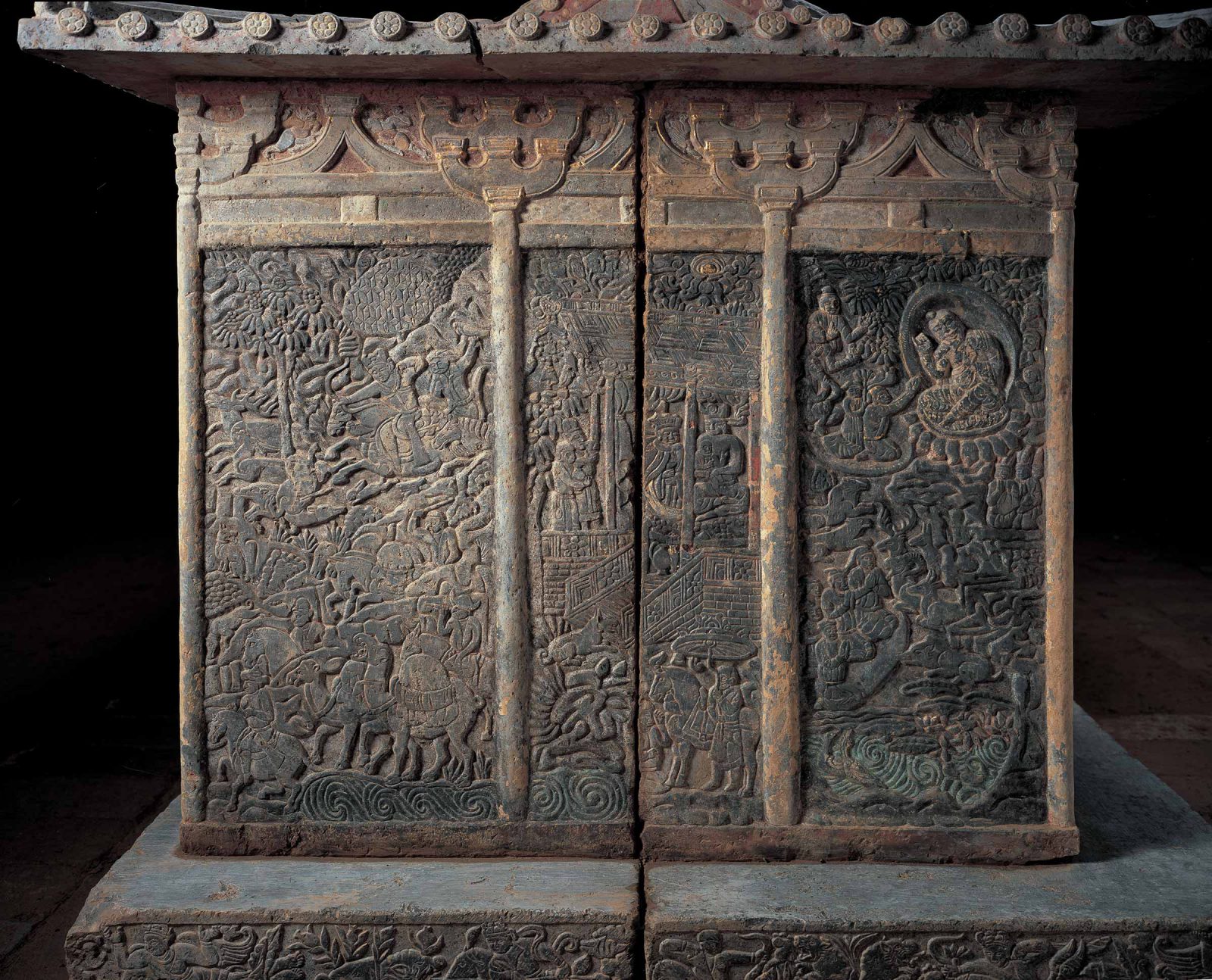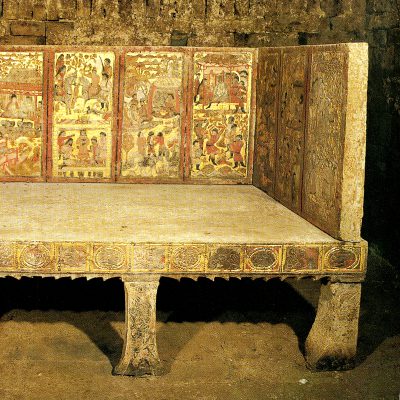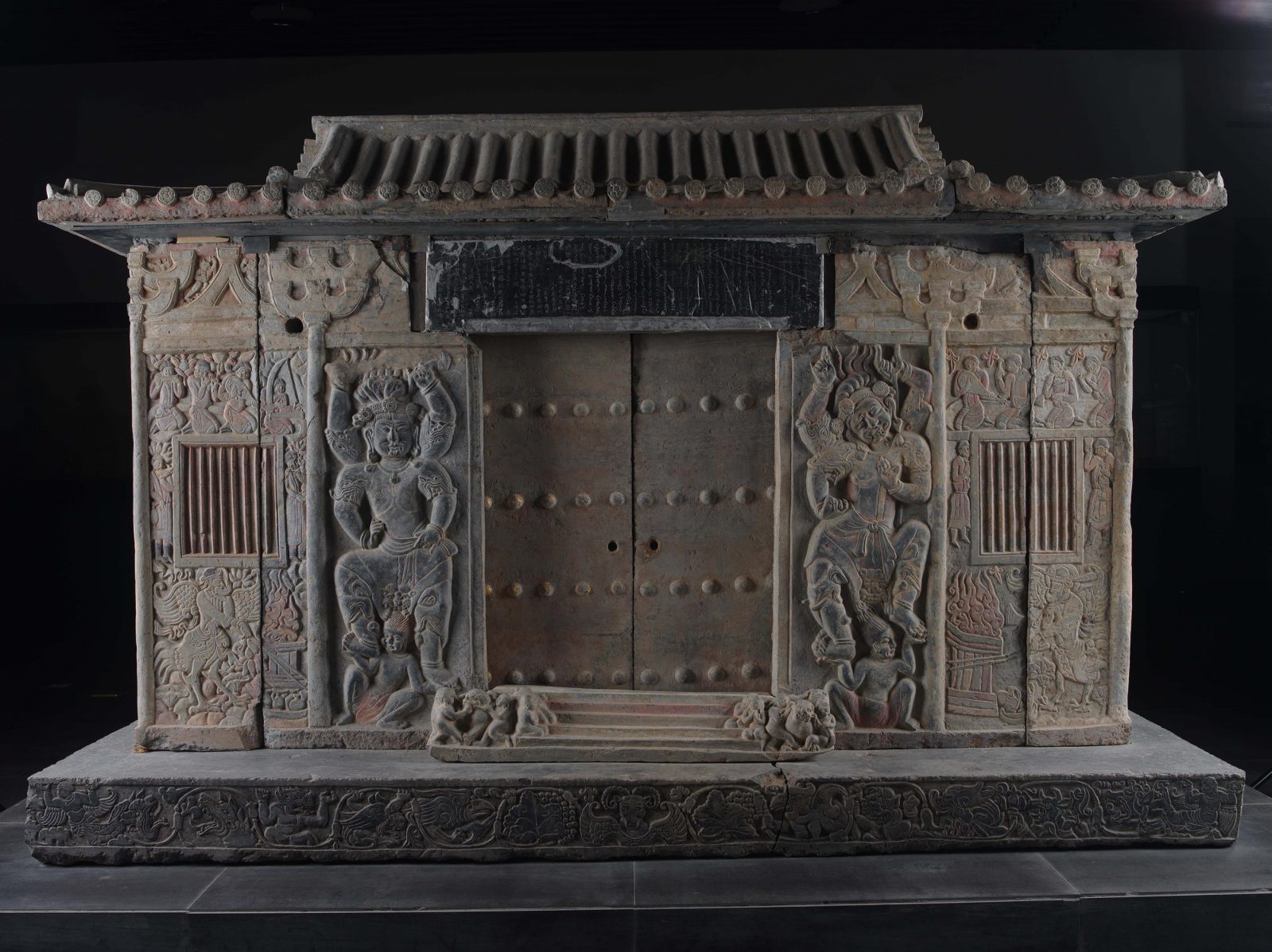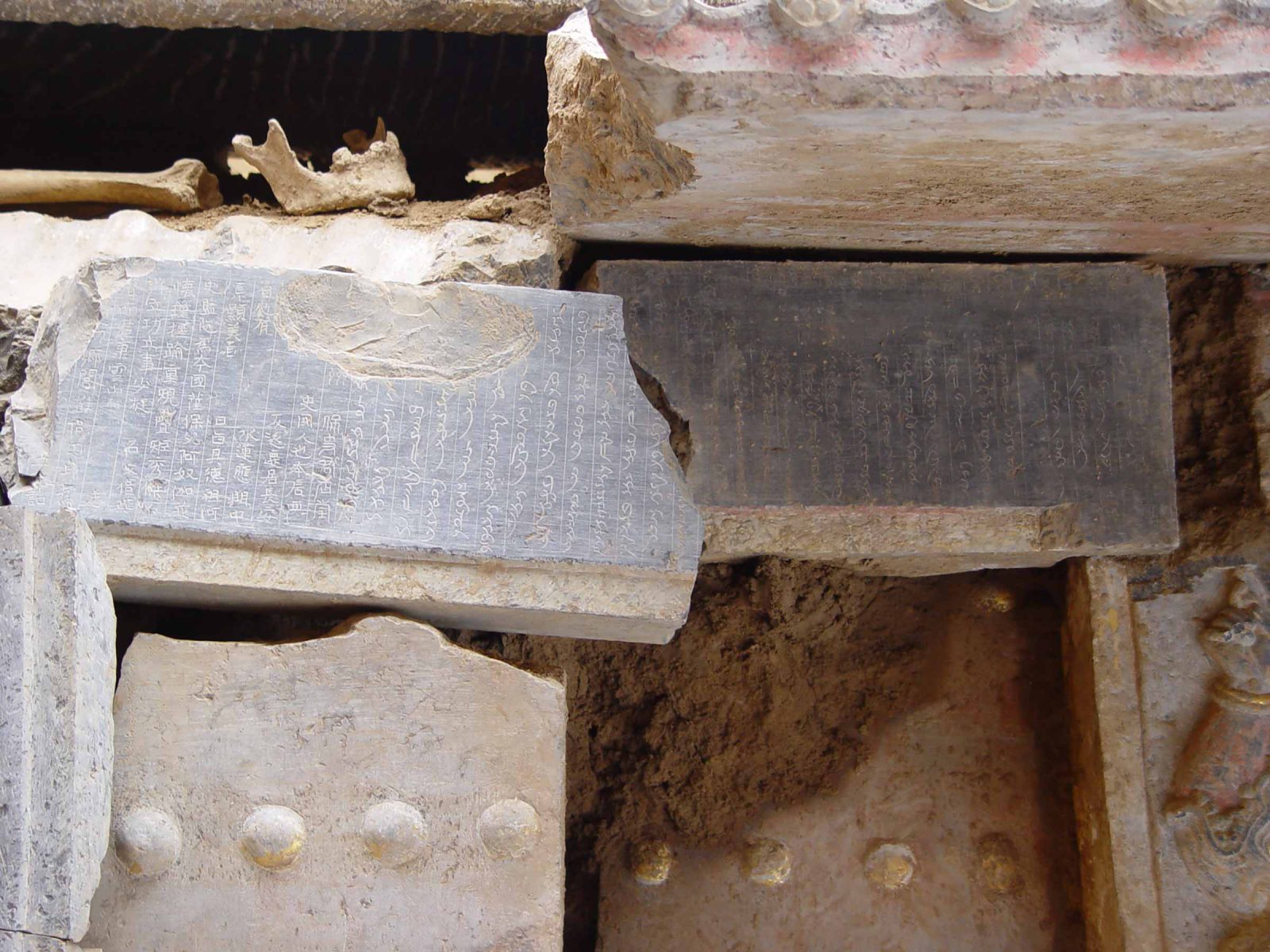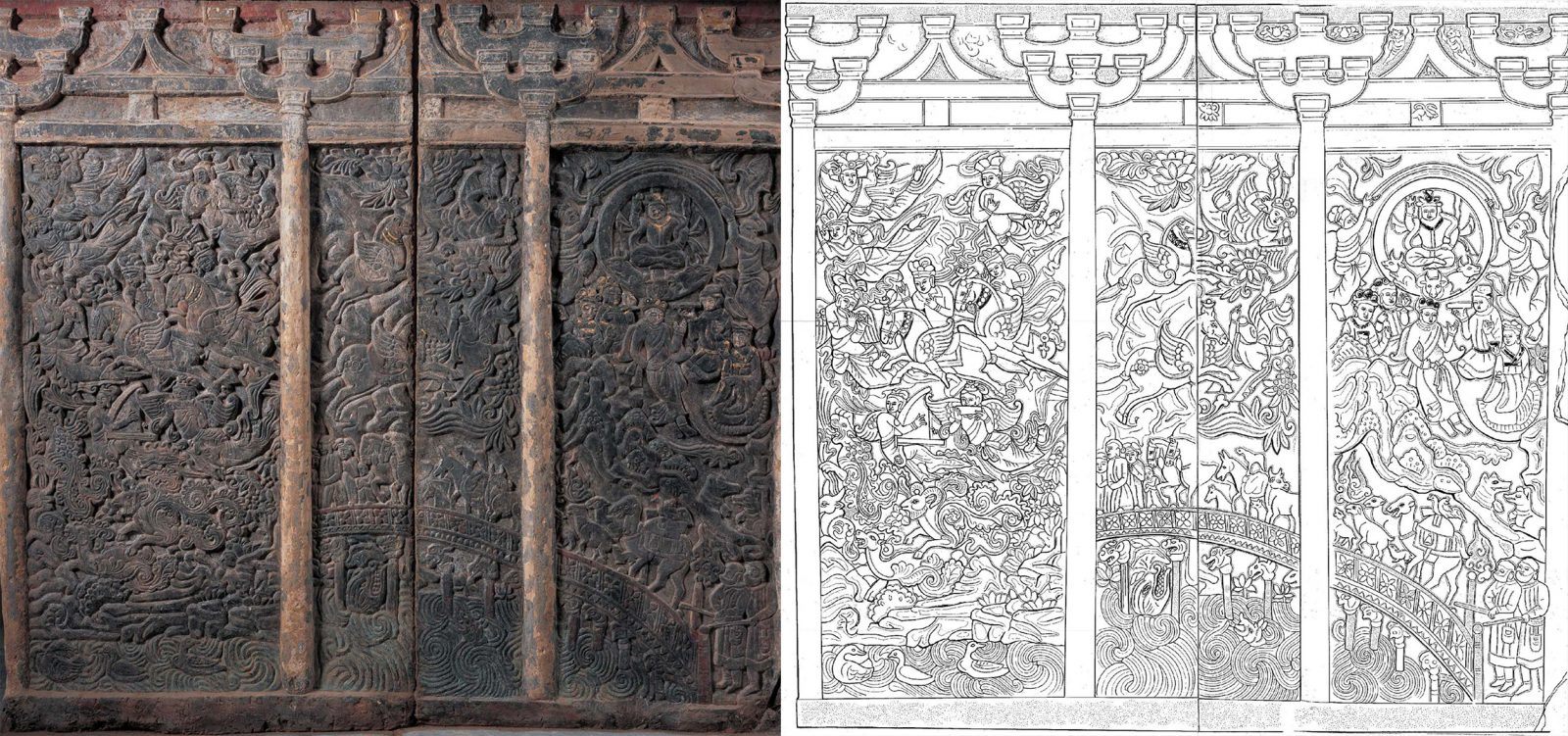
Shi Jun’s Sarcophagus
Sarcophagus of Shi Jun (Wirkak) and Wiyusi
China, Xi’an 西安市 , Shaanxi Province 陝西省, 579–80 CE
Northern Zhou dynasty (557–581 CE)
Stone carvings with traces of pigment and gilding
Shaanxi History Museum, Xi’an, China
Image courtesy of Shaanxi Provincial Institute of Archaeology
The tomb of the Sogdian community leader Shi Jun 史君 (d. 579) and his wife was found in 2003 in the northern suburbs of Xi’an, not far from those of two other persons of Sogdian origin, An Qie 安伽 and Kang Ye 康業.The Nine Sogdian Surnames Learn more about the Chinese names for Sogdian families in China The tomb consisted of a single burial chamber, at the center of which was a stone sarcophagus, or outer coffin, in the shape of a Chinese-style house. Within were a stone couch and cinnabar-red wall paintings of grapevine patterns. The tomb had previously been plundered and therefore few grave goods were found.
The outer walls of the sarcophagus present a complex program of pictorial reliefs. The front (or south) wall features studded doors flanked by four-armed tomb guardians; Fig. 1. On either side, at the lower corners of the wall, are two half-man, half-bird priests wearing mouth covers (padams) and tending to fires on altars, Fig. 2—a motif also found in An Qie’s tomb and on Sogdian ossuaries.
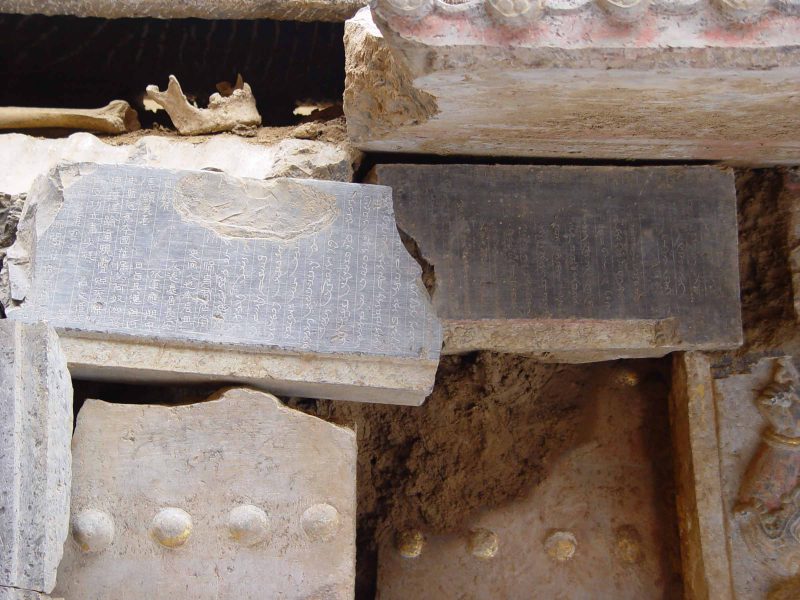
Fig. 3 Bilingual epitaph from the tomb of Shi Jun (Wirkak) and Wiyusi. China, Xi’an 西安市, Shaanxi Province 陝西省. Northern Zhou dynasty (557–581 CE); dated to 579–80 CE. Stone carvings with traces of pigment and gilding. Shaanxi History Museum, Xi’an, China.
Image courtesy of Shaanxi Provincial Institute of Archaeology.
Shi Jun’s epitaph, located on the lintel of the sarcophagus, is unusual in being bilingual; Fig. 3. The inscription describes in Chinese and Sogdian the life and achievements of Shi Jun. Although both sides generally convey the same information, the Sogdian one is better preserved. From it we learn that the Sogdian names of Shi Jun and his wife were Wirkak and Wiyusi, and that their surviving three sons commissioned the tomb’s ambitious stone carvings.
The stone reliefs were originally painted and gilded, which would have increased the overall legibility of the dense compositions. Scholars continue to debate the contents of the reliefs, but the pictorial program is generally believed to begin on the west wall, Fig. 4; to continue around the back, Fig. 5; and to finish on the east wall, Fig. 6, in a clockwise fashion. Several episodes appear to refer to Shi Jun’s occupations before and after being appointed sabao 薩保, or leader of a Sogdian community. The reliefs also depict a number of religious scenes, culminating in an elaborate illustration of Shi Jun and Wiyusi crossing the Chinvat Bridge, a Zoroastrian vision of judgment and journey to paradise described in texts but seldom represented visually. This has led one scholar to describe the reliefs as an “extremely well-informed version” of Zoroastrian texts, unique so far among the tombs of Sogdians or other Central Asians buried in China.
by Julie Bellemare
Yang Junkai, “Carvings on the Stone Outer Coffin of Lord Shi of the Northern Zhou,” in Étienne de la Vaissière and Éric Trombert, eds., Les Sogdiens en Chine, Études Thématiques 17 (Paris: École française d’Extrême-Orient, 2005), 22.
A second Sino-Sogdian bilingual epitaph was recently recognized in a Chinese museum collection. See Bi Bo, Nicholas Sims-Williams, and Yan Yan, “Another Sogdian-Chinese Bilingual Epitaph,” Bulletin of the School of Oriental and African Studies 80, no. 2 (2017): 305–18.
Shi Jun’s name in the Chinese part of the epitaph translates literally as “Master Shi,” a mark of respect; the poor condition of this part of the epitaph prevents us from knowing his given name. For a study of the Sogdian text, see Yutaka Yoshida, “The Sogdian Version of the New Xi’an Inscription,” in Étienne de la Vaissière and Éric Trombert, eds., Les Sogdiens en Chine (Paris: École française d’Extrême-Orient, 2005), 57–72.
Frantz Grenet, “More Zoroastrian Scenes on the Wirkak Sarcophagus,” Bulletin of the Asia Institute 27 (2013; published 2017): 10.


